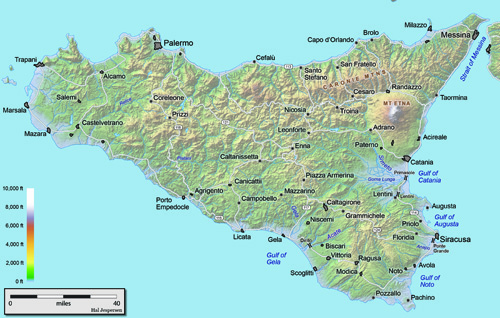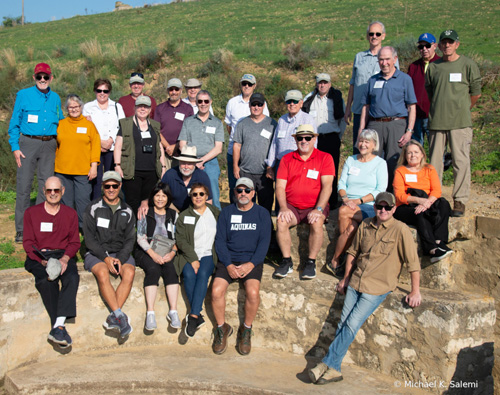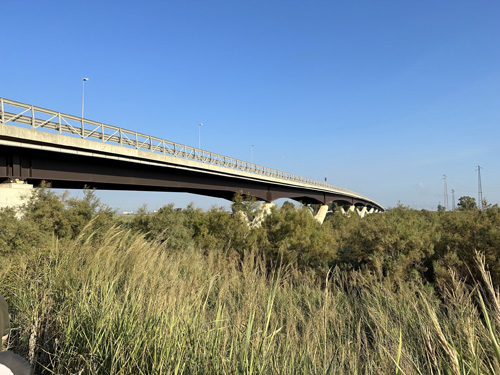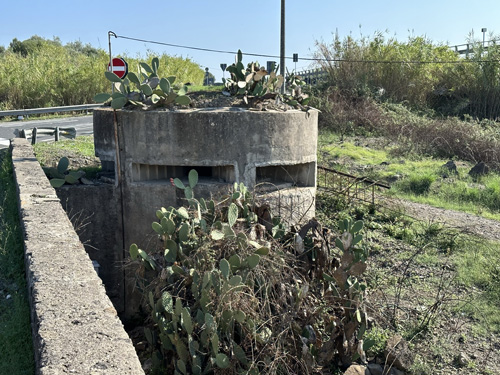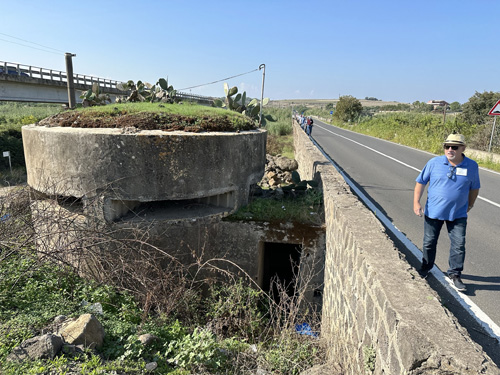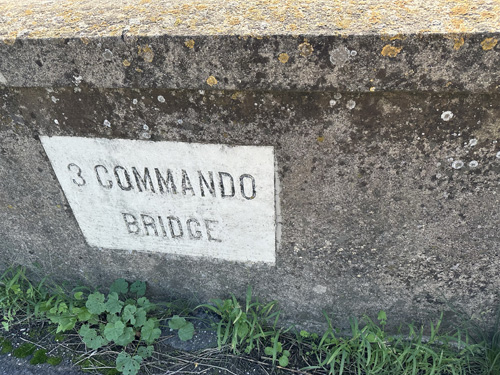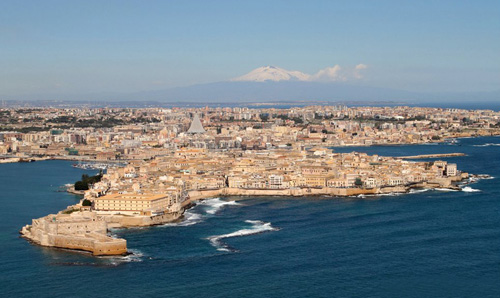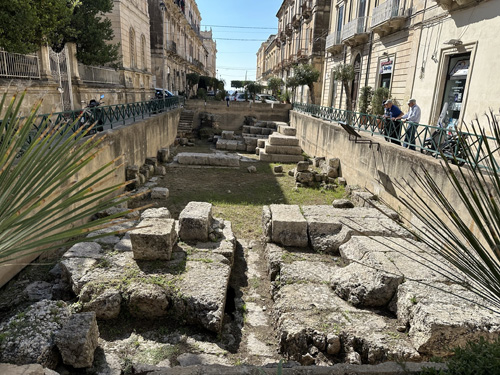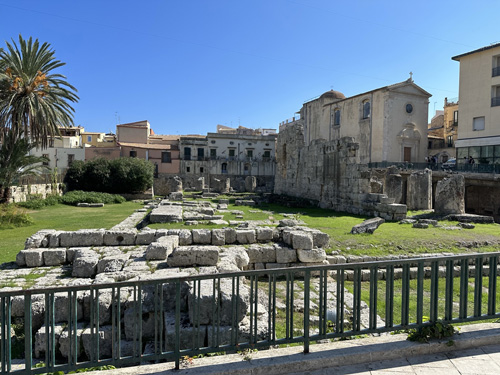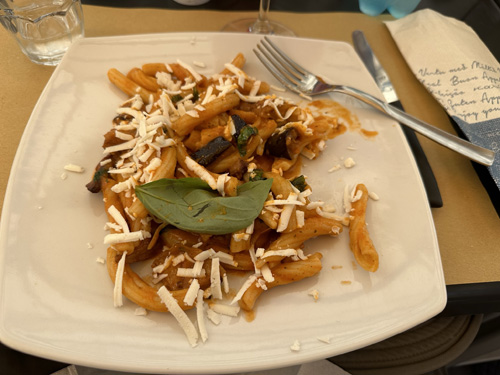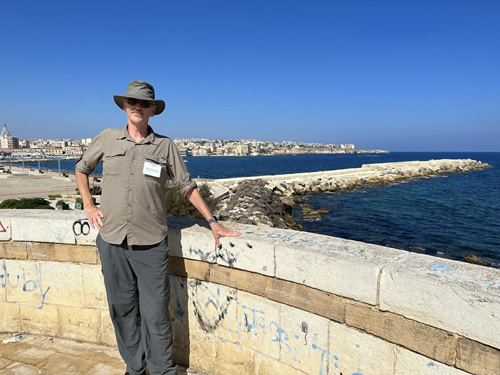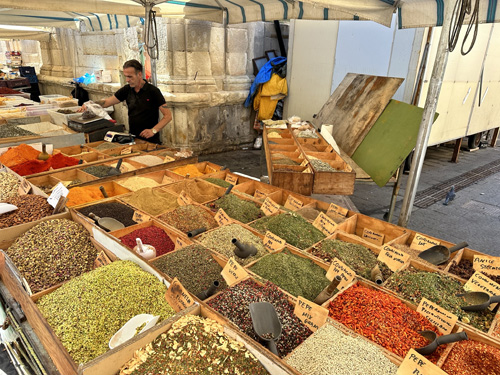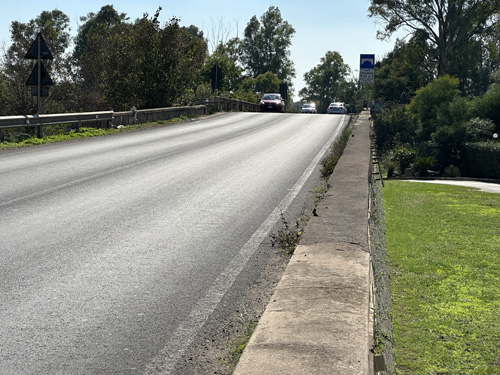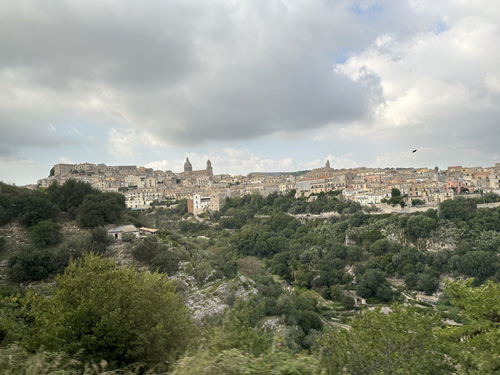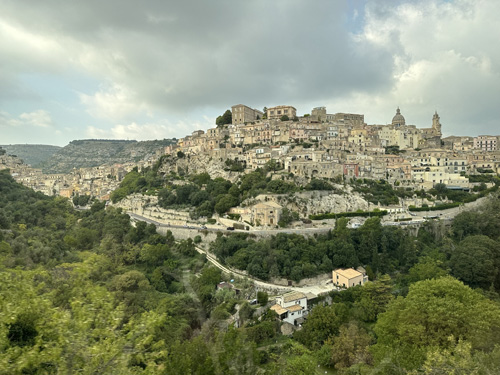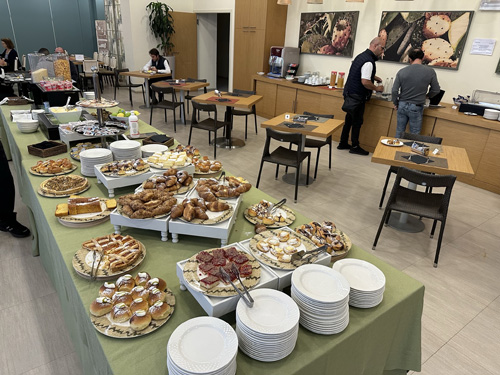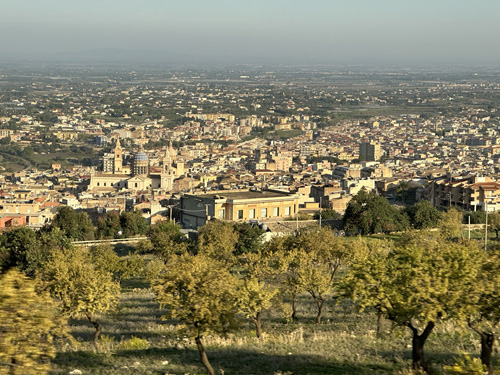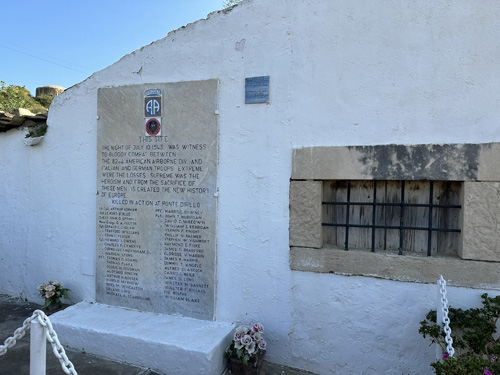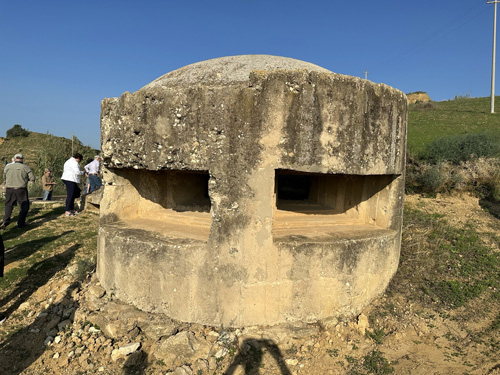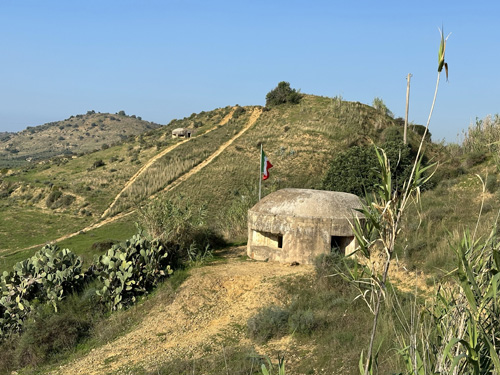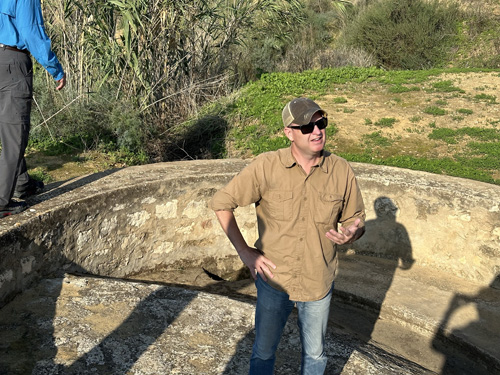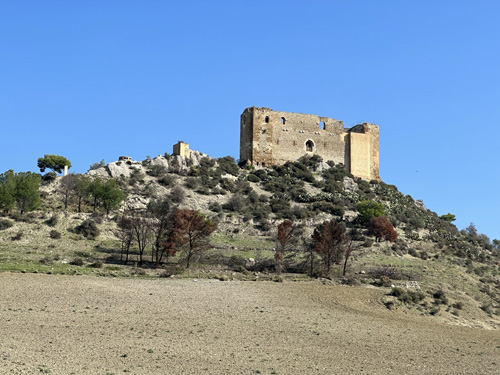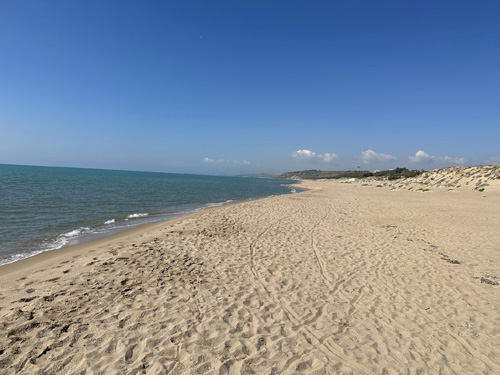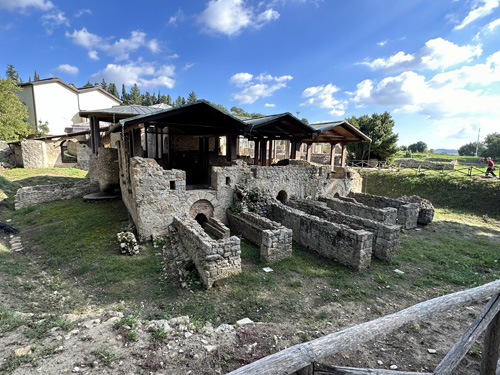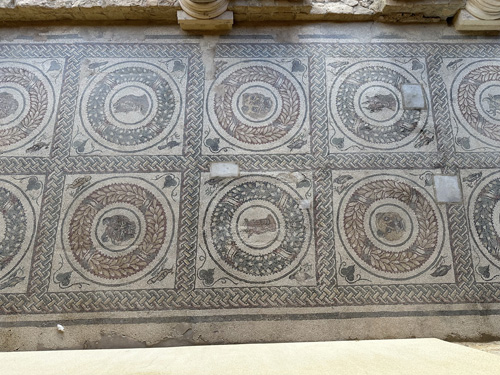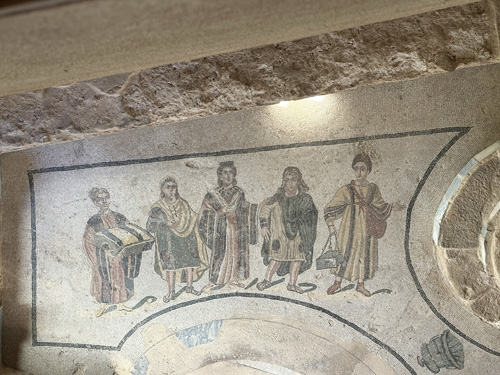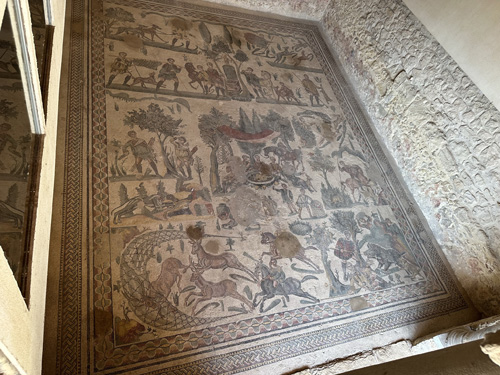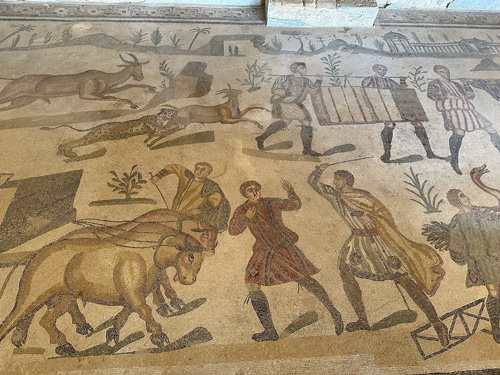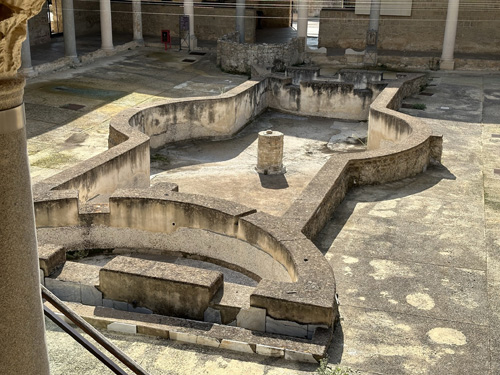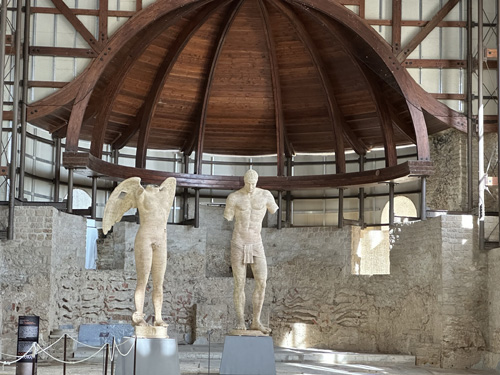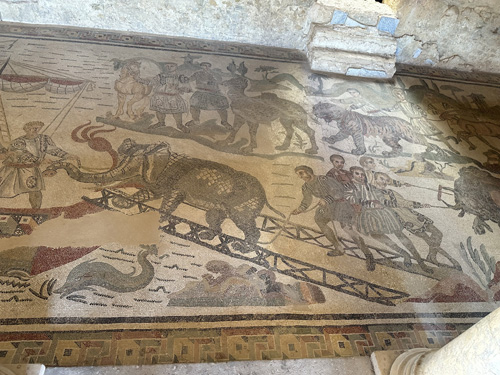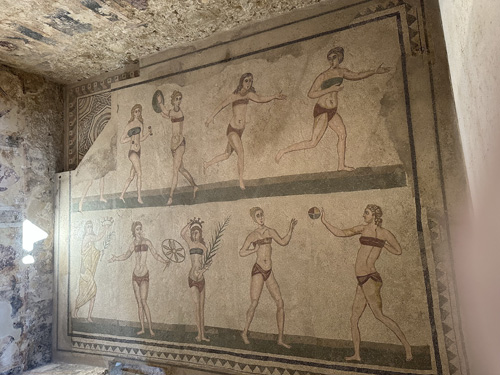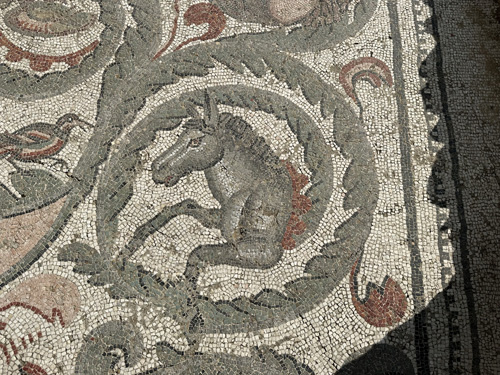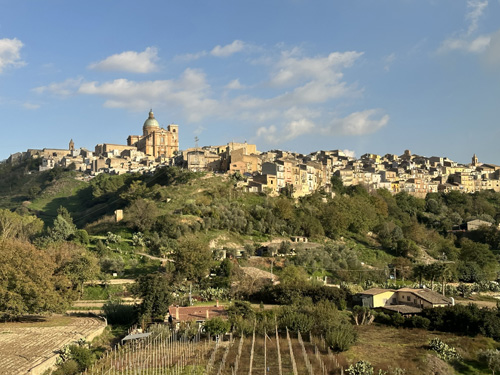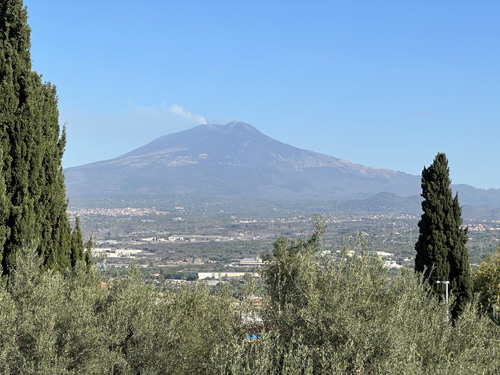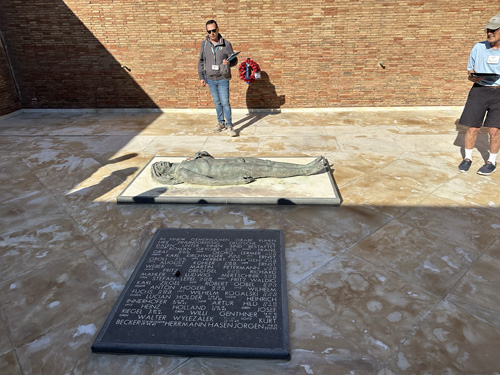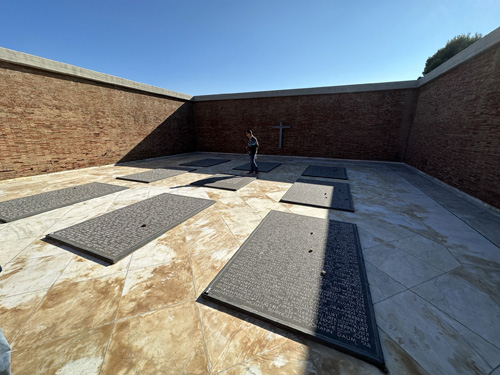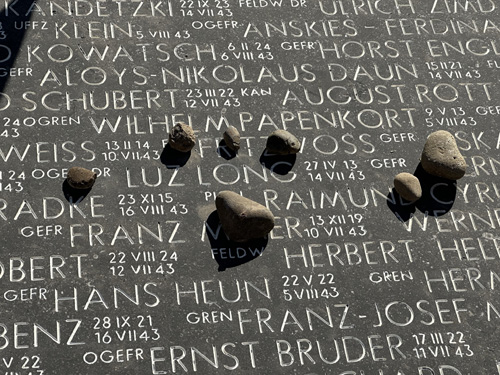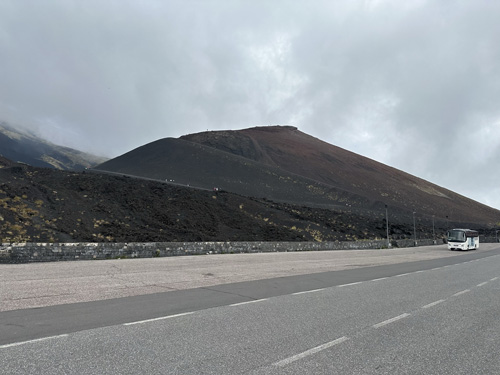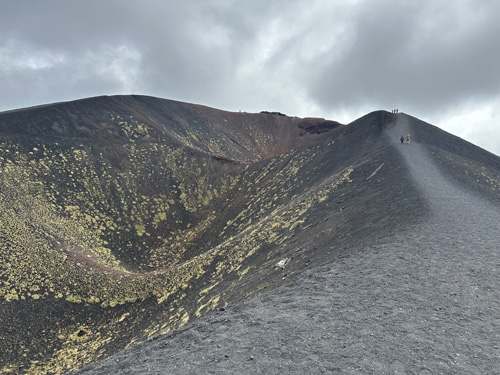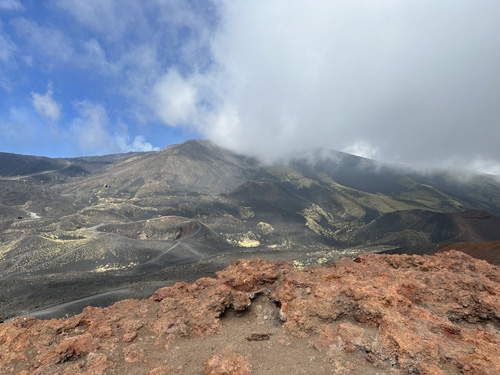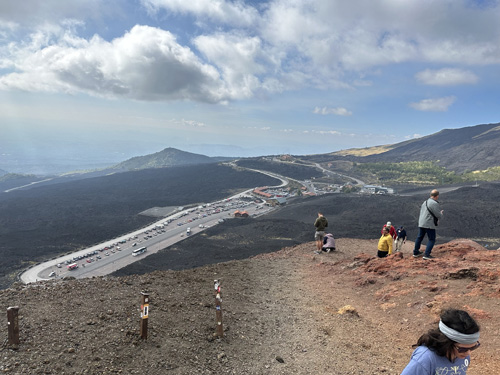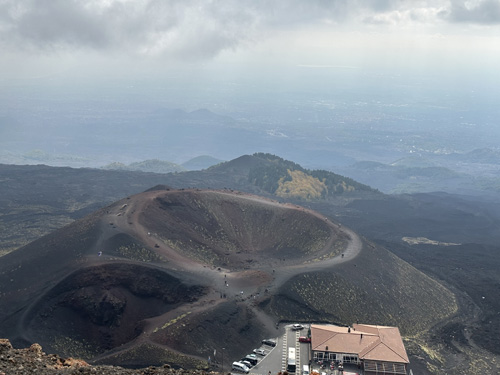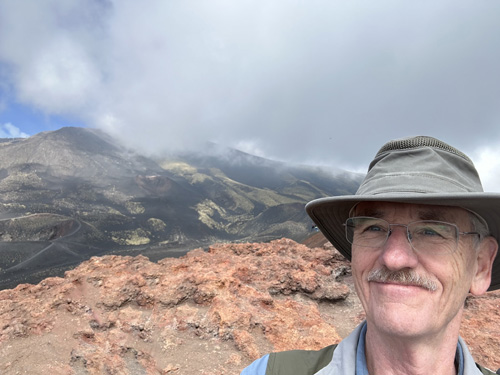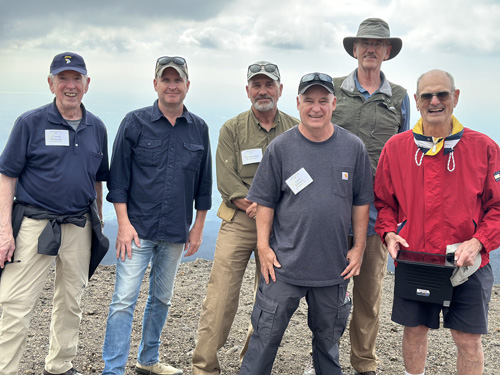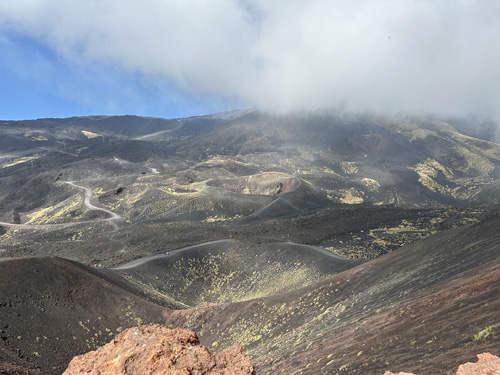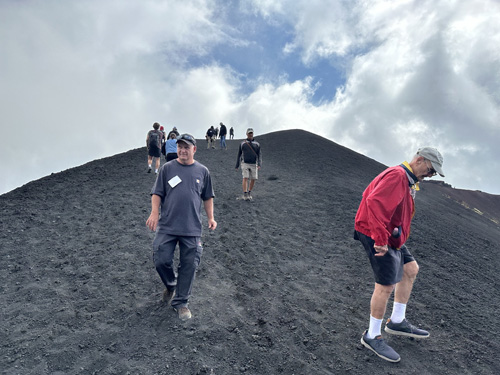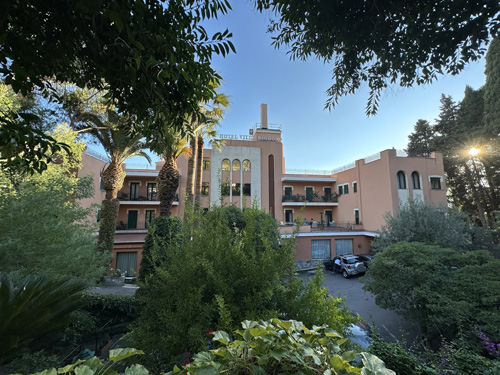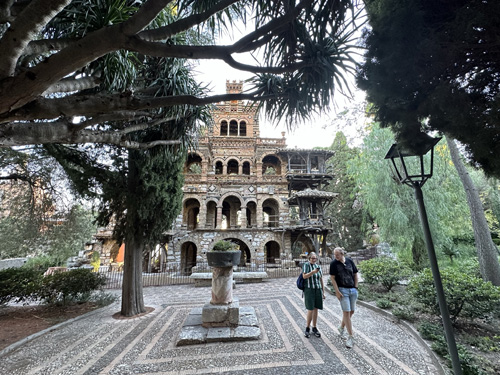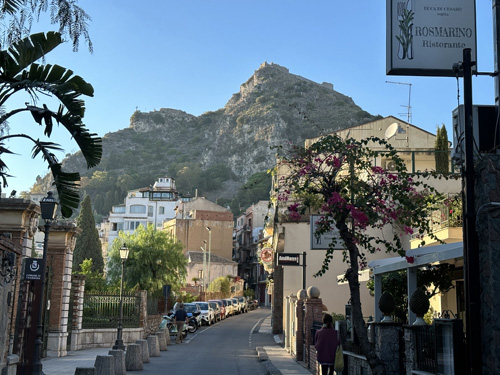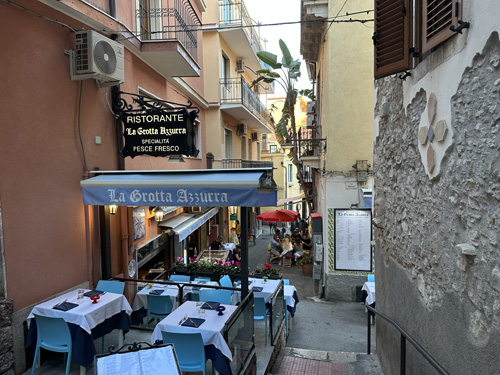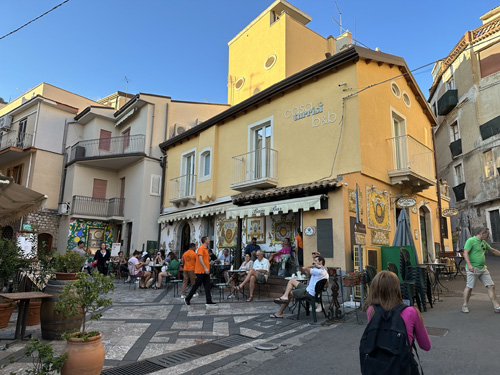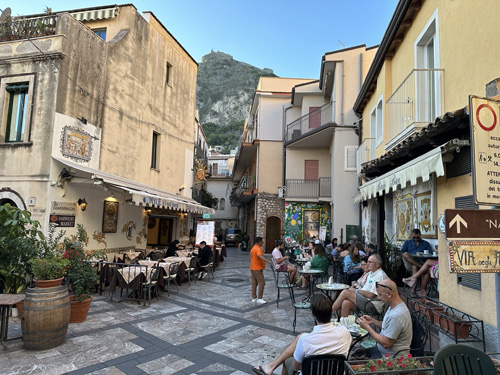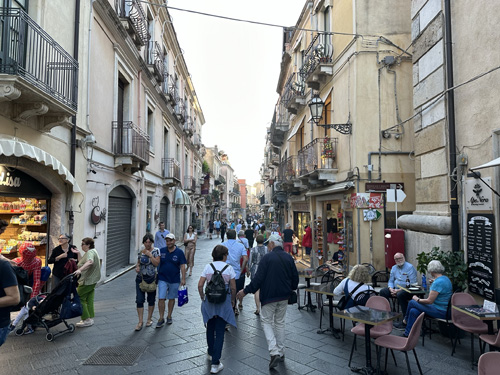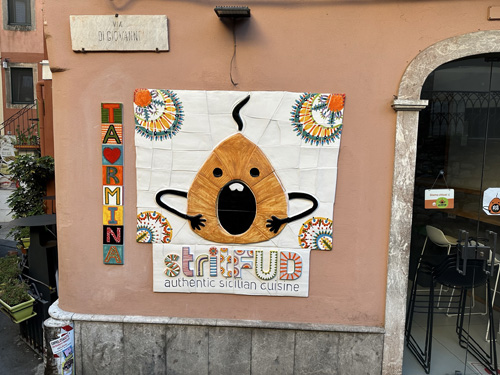Hal Jespersen's Italian Campaign Trip, October 2022
This is a continuation of Hal’s report on his trip to Italy for a tour of the World War II Italian Campaign, hosted by Stephen Ambrose Historical Tours.
This report is broken into four pages.
- Pre-tour arrival in Italy
- Sicily Campaign (this page)
- Italian Campaign: Salerno to Sorrento
- Italian Campaign: Winter Line and Anzio to Rome
Sunday, October 16 — To Catania
After colazione (breakfast—a coffee and cornetto/croissant, standing up at a narrow bar) at Termini I took the Leonardo Express to an early afternoon flight from Fiumicino on ITA Airlines, which used to be Alitalia. Rome’s main airport is really nice, modern, and clean. The duty free shop actually has bargain prices on an enormous inventory. And there are delicious panini shops; I think Italians make the best sandwiches.
Our first hotel is the Mercure Excelsior in downtown Catania. I asked about the military museum here, but it’s closed on Sundays. In fact, checking Google Maps, it seems like almost the whole city is closed on Sundays. The Ambrose group met at 7 pm for introductions as Aperol spritz aperitivi were served. Our historian is Marty Morgan and tour manager is Antonella Tisi. There are 28 attendees. Dinner in the hotel ballroom was a three-course Sicilian meal of risotto, fish, and cake for dessert. Our table had a lively discussion about World War II movies.
I’m interested to see the Sicily Campaign, Operation Husky, because in the 1970s I served in two divisions that were here: 2nd Armored and 9th Infantry!
Monday, October 17 — Syracuse and Ragusa
Breakfast at 7 (extravagant American style rather than the Italian espresso and croissant), bags out in the hall at 7:30, bus at 8. Bus seating was a bit cramped, but I was able to get a seat by myself and manspread. Catania is a rather dilapidated city and we had heavy traffic getting out through narrow streets. Our first stop was the Primasole bridge, where in Operation Fustian, the British 1st Parachute Brigade dropped and glided in 25 miles north of the main British force, the 50th ID, to hold the bridge over the Semito River. Casualties were extremely high, and they were driven back by the Germans, but at least they were able to remove the pre-placed demolition charges so the bridge remained available for the drive north. The WWII bridge has been replaced by a modern, much longer, highway bridge. And three of the four Italian blockhouses are gone.
After a highway rest stop, we drove to the Lentini bridge, which is still there in its mostly original form. It is marked as the 3 Commando Bridge (by Montgomery during the campaign itself) because that group did an amphibious landing 5 miles east and marched to seize the bridge. As with Primasole, they were quickly driven off by German counterattacks, but prevented the bridge from demolition. There are two pillboxes still there and we got a good external look at the closer one.
Lunch was in Siracusa’s Isola di Ortigia. A group sat at a nice sidewalk café where I had Pasta alla Norma, a Sicilian specialty that is heavy on eggplant. We took a walk for a scenic view of the harbor and through a few farmers markets.
Just south of Siracusa was our third bridge of the day, the Ponte Grande, still in its original condition. We were prevented by traffic and closed gates from getting right up to it. Here Operation Ladbroke sent 144 glider loads of men and materiel to seize the bridge, but 52 crashed into the sea and only 14 actually reached their landing site. Once again the Brits were outnumbered and repelled, but they prevented the demolition of the bridge, which is very close to the northernmost British landing beach, so it vital to keep that road open.
We drove about an hour west to Ragusa, which is a spectacular small city on a series of very steep hills, houses seemingly stacked directly on top of each other. Our hotel, a bit out town on a flat area, is the Poggia del Sole Resort. It’s very modern and comfortable (although the Wi-Fi was lousy). Dinner was with the group in the beautiful hotel restaurant, a nice Sicilian meal of cavaltini pasta and involtini with caponata, complimented by a very good Nero d’Avala.
Tuesday, October 18 — Gela, Piazza Armerina, and Enna
Same timing. We drove about an hour south and enjoyed spectacular views, coming down from the Ragusa hills, of the towns of Vittorio and Comiso. Marty narrated about the American Seventh Army landings and also lots of details about US vehicles, from tanks to jeeps to DUKWs. He gave us details of Col. James Gavin’s off-course parachute landing and gathering up about 200 of the scattered 82nd Airborne troops into an ad hoc group that descended from Biazza Ridge and ran into the start of the German counterattack, putting a damper on the enemy’s progress, despite being significantly outgunned.
We stopped at the 82nd Airborne memorial near Ponte Dirillo and climbed the hill to examine a few Italian bunkers. At the Y Intersection of highways 115 and 11, below Plano Lupo, we stayed on the bus to hear about Captain Ed Sayers of the 82nd who had to take the intersection with a small group, but faced some significant bunkers. He was able to bluff the Italians into surrendering by threatening them with 6-inch naval gunfire from the USS Savannah.
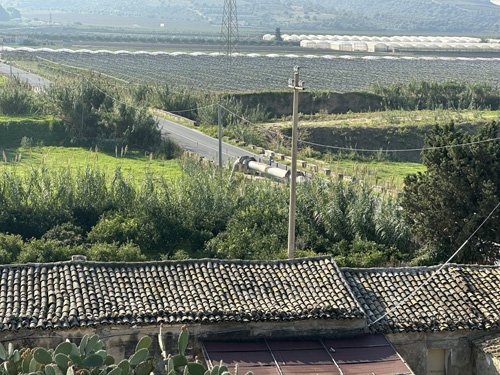
We drove north on highway 117, passed by the abandoned Ponte Olivo airfield, and stopped near a magnificent castle called Casteluccia di Gela, which had a role as an observation point and was in a string of bunkers. We stood by the bus, unwilling to climb up the hill. (Wimps!) Marty talked about using artillery to blunt the counterattack by the Livorno Division—105 mm howitzers, 4.2-inch mortars (conventional rounds from a chemical warfare battalion), and naval. He also told the story in great detail of the Ill-fated B24 called Lady Be Good. By this time the crowd was antsy for a bathroom break, so we proceeded to the city of Gela, which is larger than I was expecting. We stopped at a cafeteria-like place and I had a pretty good panino. But according to Antonella, there is nothing else to see in Gela, so I had some idle typing time on the bus.
Next was one the landing beaches. We found an access point about a quarter mile from where Patton came ashore. (Gela has a lot of road construction and we found that navigating unexpectedly closed roads with a big bus was sometimes challenging.) It’s a beautiful beach, stretching for miles, and yet we saw no one swimming or sunbathing.
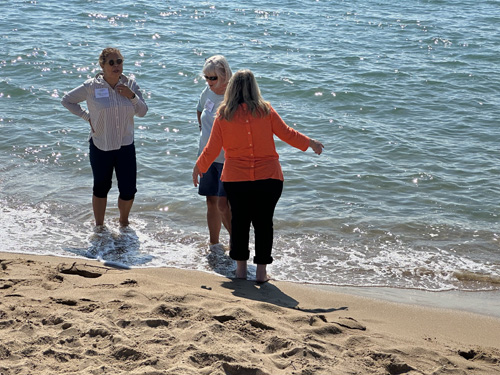
North on 117 brought us into mountainous country. We stopped in the pretty town of Piazza Armeria at the Villa Romana del Casale. This is a late-era Roman villa that is partially preserved with an astonishing number of beautiful floor mosaics. The photos I show below are only a fraction of those on view.
Our hotel tonight is Federico II Palace Hotel in Enna, right in the middle of Sicily. It is a large traditional European hotel. At least the Wi-Fi works. But I just cannot get used to the crazy complicated light switch situation in these hotels. Dinner with the group in the hotel restaurant was a selection of Sicilian appetizers and a fabulous risotto. Plus a tasty Sicilian Syrah, a first for me.
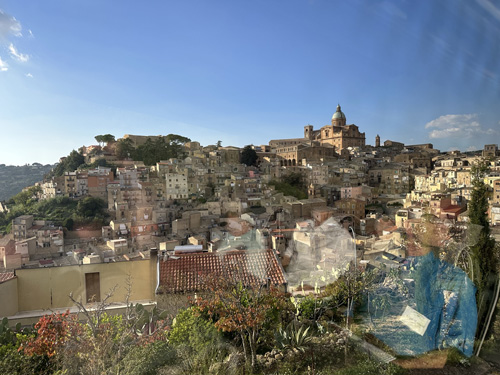
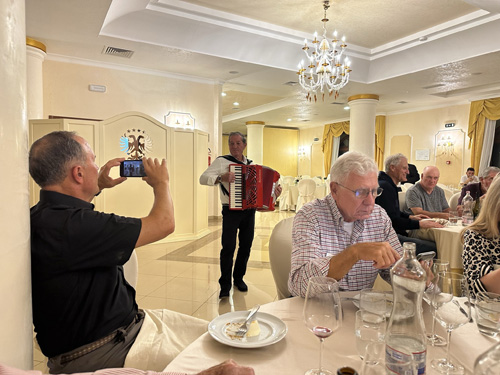
Wednesday, October 19 — Catania, Mt Etna, and Taormina
We were scheduled to visit the Castello di Lombardia, a fortress built around 100 BC, but ever-encroaching road closures foiled our plan, so we drove around Enna a little to understand the general topology of central Sicily, where Patton’s army advanced—mountainous terrain, with many small towns perched on steep hills. The good panoramic views always seemed to be on the other side of the bus, through which I don’t like to photograph. As we rode, Marty lectured on Mussolini’s ouster, the German Etna Line defense, the Patton–Montgomery controversy over highway 124, and the relief of Terry Allen from the 1st ID. We headed back to Catania. Along the way got views of Mt Etna, which Marty said has grown 100 feet in the past two years, now at over 11,000 feet. One positive result of the COVID era, I guess.
Our first stop was Motta – St. Anastasia, the only German war cemetery in Sicily, where 4,561 men are interred below a series of mausoleum courtyards, each geographically named for the area of the death. The largest of these, Catania, had many related to the action at Primasole bridge. Over the years relatives have visited and placed small stones next to the names of their dead. One important name was of Carl Ludwig “Luz” Long, the long jumper who befriended, and lost to, Jesse Owens at the 1936 Berlin Olympics. The German cemeteries across the world are not maintained by the government, but by a private group called Volksbund Deutsche Kriegsgräberfürsorge e. V., which formed with inspiration by Albert Schweitzer. Apparently Marty received some negative feedback from the group for selecting this stop, but I found it moderately interesting.
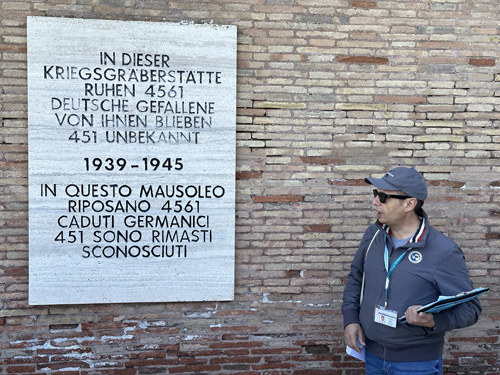
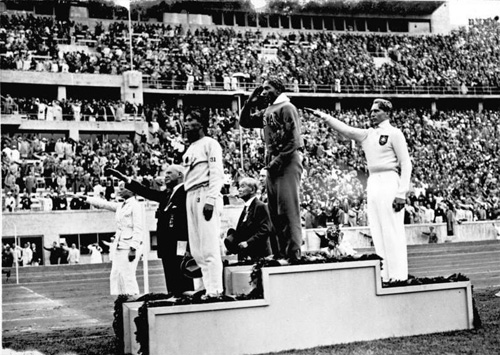
We drove into the Etna foothills in the Catania exurbs, which seem a lot nicer and more prosperous than the central city. Our lunch stop was the town of Nicosoli, which was a key point in the Etna Line, and where there were a few small cafés. I ended up with a spinach and cheese turnover pastry that was a decent lunch for 2€! Then up the mountain on a very windy road, which reached as far up as normal vehicles can go, but only about halfway to the summit, where there is large tourist shopping center, Rifugio Sapienza at 6,200 feet. It is amazing to see a few houses being built on an active volcano! The view of the Catania plain and the sea would have been spectacular but for some clouds and haze.
We were given two hours to spend on Etna, so a few of us trooped up a nearby crater, Crateri Silvestri Superiori, which looks impossibly steep and high from the road, but is actually only 260 feet high (according to Open Topo Map) or 320 (per my Apple Watch). Some parts of the descent were a little slippery on gravel, but all of our group made it up and down without incident. There was a cable car that went way up the mountain, which was covered in clouds, so I didn’t bother. Afterward I stopped at a café and had a torta al pistacchio.
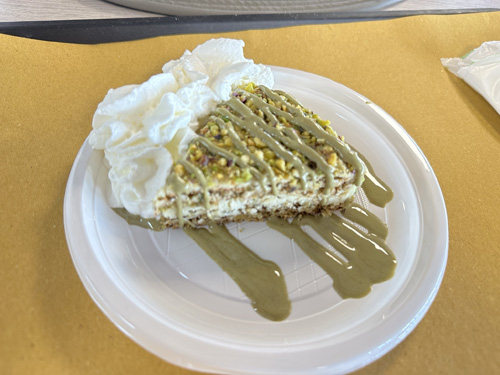
We took the winding return road down toward the coast and then headed north to Taormina. This is beautiful little town on a steep hill overlooking the Ionian Sea, so we negotiated a number of switchbacks to get near our hotel; our bags had to be delivered separately from the remote bus garage. Our hotel is Villa Diodoro, which is a bit rundown, but in a great location, with sea views from large room balconies and the vibrant downtown a five-minute walk away. Since we got there at 4:30, I had time to wander around and wish we were eating at one of the trendy restaurants tonight. I suspect that tour groups get discounts if they book both rooms and meals. Anyway, the hotel dinner was rather mediocre with poor wine selections.
